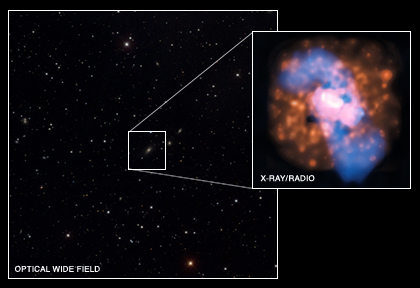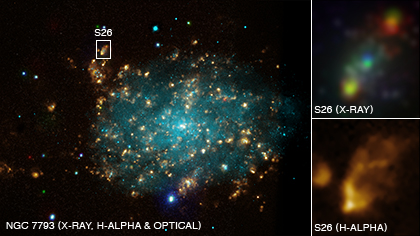Galaxies spiralling out of control
Updated: 2010-07-31 00:06:21
 Today’s OOTW features Alice’s OOTD, posted on the 29th of July.
This is AHZ40004wr, a galaxy residing in the constellation Taurus around 3 billion light years away. It’s a wonderful spiral galaxy, and following its spiral arms is a large dust lane, a place full of young stars and stars that are only just being [...]
Today’s OOTW features Alice’s OOTD, posted on the 29th of July.
This is AHZ40004wr, a galaxy residing in the constellation Taurus around 3 billion light years away. It’s a wonderful spiral galaxy, and following its spiral arms is a large dust lane, a place full of young stars and stars that are only just being [...]
 One topic which generated a lot of discussion at the Gravity and Cosmology meeting was the void model of the Universe. The basic argument is simple: the dark energy is an ugly addition to our cosmological standard model, with 70% of the energy density of the Universe some mysterious substance with weird properties. From a [...]
One topic which generated a lot of discussion at the Gravity and Cosmology meeting was the void model of the Universe. The basic argument is simple: the dark energy is an ugly addition to our cosmological standard model, with 70% of the energy density of the Universe some mysterious substance with weird properties. From a [...] Exploring our dark universe is usually the domain of extreme physics. Clues to dark matter and energy are searched for by huge neutrino telescopes and particle detectors, deep underground, and by experiments launched into space. But an experiment doesn't have to be exotic to explore the unexplained. At the International Conference on High Energy Physics, which ends today in Paris, scientists from the GammeV-CHASE experiment unveiled the first results from their experiment, which used 30 hours' worth of data from a 10-meter-long experiment to place the world's best limits on particles of dark energy.
Exploring our dark universe is usually the domain of extreme physics. Clues to dark matter and energy are searched for by huge neutrino telescopes and particle detectors, deep underground, and by experiments launched into space. But an experiment doesn't have to be exotic to explore the unexplained. At the International Conference on High Energy Physics, which ends today in Paris, scientists from the GammeV-CHASE experiment unveiled the first results from their experiment, which used 30 hours' worth of data from a 10-meter-long experiment to place the world's best limits on particles of dark energy. This galaxy is featured in LizPeter’s OOTD for 24th of July 2010.
This is Messier 63, though I much prefer its other name, the sunflower galaxy. It’s a wonderful dusty spiral galaxy lying 22.9 million light years away from Earth in the constellation Canes Venatici. It’s one of 7 galaxies bound gravitationally together in the M51 [...]
This galaxy is featured in LizPeter’s OOTD for 24th of July 2010.
This is Messier 63, though I much prefer its other name, the sunflower galaxy. It’s a wonderful dusty spiral galaxy lying 22.9 million light years away from Earth in the constellation Canes Venatici. It’s one of 7 galaxies bound gravitationally together in the M51 [...] This image shows the effects of a giant black hole that has been flipped around twice, causing its spin axis to point in a different direction from before.
This image shows the effects of a giant black hole that has been flipped around twice, causing its spin axis to point in a different direction from before. Combining observations made with ESO�s Very Large Telescope and NASA�s Chandra X-ray telescope, astronomers have uncovered the most powerful pair of jets ever seen from a stellar black hole.
Combining observations made with ESO�s Very Large Telescope and NASA�s Chandra X-ray telescope, astronomers have uncovered the most powerful pair of jets ever seen from a stellar black hole.